Walkthrough - Processing a Purchase Order for Variable Weight-Lot in/Serial Out Items
In this walkthrough, you will learn how to process a purchase order for variable weight items in the Lot in/Serial Out scenario.
When using the Lot in/Serial Out scenario, the total weight of all of the cases for a specific lot is recorded for all INBOUND and MOVE transactions, and specific case weights are recorded according to serial number for OUTBOUND transactions.
Function Background
Variable weight is part of inventory management, and is used for items that are purchased, manufactured and sold in discreet units (for example, CASE or BOX) but where each unit has a variable weight and is therefore priced by weight.
When using the Lot In/Serial scenario for variable weight, it means that a total weight is assigned to the entire lot rather than individual cases for INBOUND and MOVE transactions, and that an individual weight is assigned to each serial number for OUTBOUND transactions.
For INBOUND and MOVE transactions, the Item Ledger entries, and Warehouse entries record a transaction for the lot number. For OUTBOUND transactions, the Item Ledger entries record a transaction for each serial number, and the Warehouse entries record a transaction for the lot number.
The item tracking code, which is assigned to an item, is how JustFood determines how variable weights are handled.
About This Walkthrough
This walkthrough provides an overview on how to do the following:
Story
The JF Company purchases and receives bulk cheese items. These cheese items are priced according to weight, and any surcharges are also distributed based on weight.
The SEATTLE location has been set up as a warehouse that uses non-directed put-aways. At the SEATTLE location, the JF company is purchasing 2 cases of bulk cheddar cheese (VW-LISO-CHEDDARCHEESE) and 3 cases of bulk mozzarella (VW-LISO-MOZACHEESE), both of which are received as cases but priced in pounds. A case of cheddar is expected to weigh 10 pounds. A case of mozzarella is expected to weigh 6 pounds.
When the 2 cheddar cheese cases are received, the total weight of the cases is 21.2 pounds. When the 3 mozzarella cases are received, the total weight of the cases is 17.8 pounds.
When the vendor invoice is received, the vendor has charged a delivery surcharge. When the purchase order is invoiced, the surcharge is split between the items based on the total lot weight.
Prerequisites
Creating a Variable Weight Item
The following procedures explain what needs to be done in order to create a variable weight item for the Lot In/Serial Out scenario:
To create an item tracking code
Choose the Search icon, enter item tracking, and choose Item Tracking Codes. The Item Tracking Codes window opens.
On the Home tab, choose New. The Item Tracking Code Card window opens.
On the General FastTab, enter the following information:
On the Serial No. FastTab, select SN Specific Tracking, under Outbound, select SN Sales Tracking and SN Manufacturing.
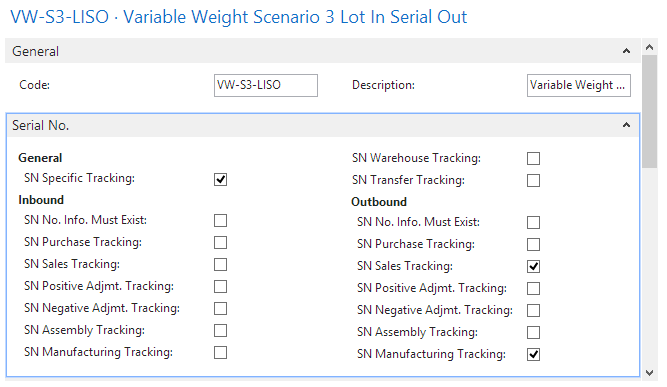
On the Lot No. FastTab, select all of the check boxes except for Lot No. Info Must Exist under Inbound and Outbound.
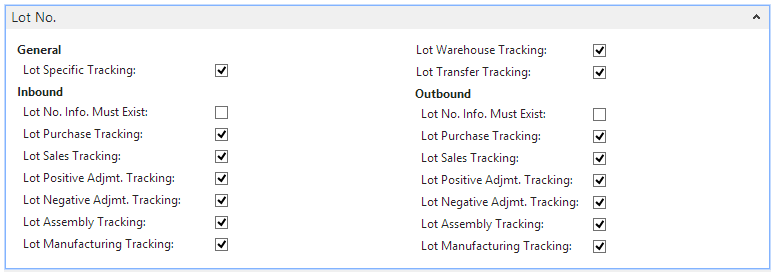
On the Misc. FastTab, select the Variable Weight Tracking check box.

Close the window.
To Create a Variable Weight Item
A variable weight item needs to be created for the bulk cheddar cheese (VW-LISO-CHEDDARCHEESE) and bulk mozzarella (VW-LISO-MOZACHEESE) that will be purchased.
A case of cheddar is expected to weigh 10 pounds. A case of mozzarella is expected to weigh 6 pounds.
Choose the Search icon, enter items, and choose Items.
On the Home tab, choose New.
On the General FastTab, enter the following information:
No.: Enter VW-LISO-CHEDDARCHEESE.
Description: Enter Cheddar Cheese Bulk.
Item Category Code: Select RAW.
Create the item's units of measure.
On the Navigate tab, in the Master Data group, choose Units of Measure. The Item Units of Measure window opens.
Add the following records:
| Code |
Qt. per Base UOM |
Weight |
| CASE |
1 |
10 |
| LBS |
10 |
1 |
Select CASE in the Base Unit of Measure field.
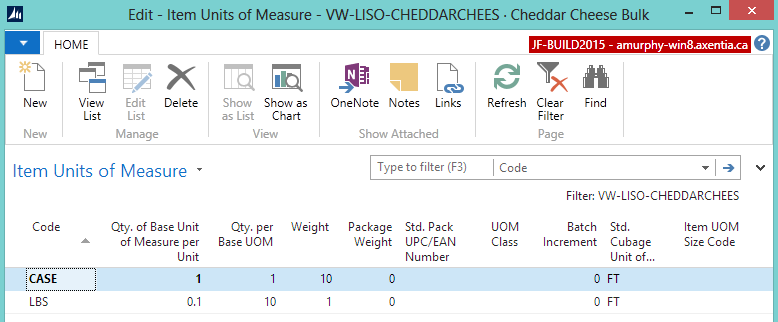
Click OK.
The Base Unit of Measure field is populated with CASE on the General FastTab.

On the Invoicing FastTab, enter the following information.
Costing Method: Select FIFO.
Sales Price Unit of Measure Code: Select LBS.
Purchase Price Unit of Measure: Select LBS.
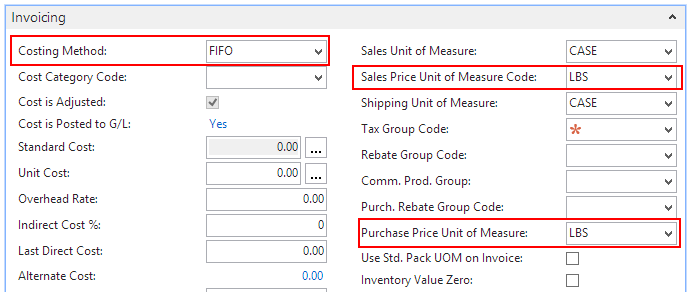
On the Item Tracking FastTab, enter the following information.
Item Tracking Code: Select VW-S3-LISO.
Serial Nos.: Select SERIAL.
Lot Nos.: Select LOT.
Expiration Calculation: Enter 6M.

On the Actions tab, in the Functions group, choose Weight>Calculate Net Weight.
The Net Weight field is populated on the E-Ship FastTab. The net weight is calculated based on the defined units of measure. The net weight flows to document lines (sales, picks, warehouse entries).
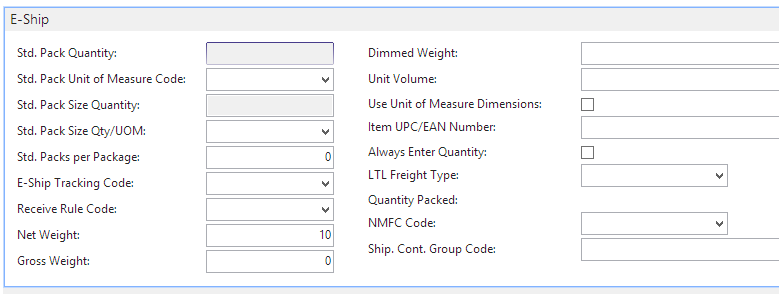
Close the Item Card window.
Repeat the steps except enter VW-LISO-MOZACHEESE in the No. field, enter Mozzarella Cheese Bulk in the Description field, and enter the following for the UOM:
| Code |
Qt. per Base UOM |
Weight |
| CASE |
1 |
6 |
| LBS |
6 |
1 |
Creating a Variable Weight Purchase Order
Choose the Search icon, enter purchase orders, and select Purchase Orders.
On the Home tab, choose New. The Purchase Order window opens.
Select a vendor in the Buy-From Vendor No. field.
If not already displayed, show the Line Net Weight, Line Net Weight to Receive, Line Net Weight Received, Line Net Weight to Invoice and Line Net Weight Invoiced columns on the Lines FastTab.
Enter information on the Lines FastTab for the cheddar.
Type: Select Item.
No.: Select VW-LISO-CHEDDARCHEESE.
Location Code: Select SEATTLE.
Quantity: Enter 2.
The value in the Unit of Measure field should represent the base UOM. This value should NOT be the unit of measure for the weight.
Direct Unit Cost (Purch. Price UOM): Enter 2.50. This is the cost of the item based on its weight. Therefore, the cost of the cheddar is $2.50 per pound.
The Direct Unit Cost Excl. Tax field is automatically populated with 25.00, which is the price per CASE. One CASE is expected to weigh 10 LBS at $2.50 per pound.
Enter information on the Lines FastTab for the mozzarella.
Type: Select Item.
No.: Select VW-LISO-MOZACHEESE.
Location Code: Select SEATTLE.
Quantity: Enter 3.
The value in the Unit of Measure field should represent the base UOM. This value should NOT be the unit of measure for the weight.
Direct Unit Cost (Purch. Price UOM): Enter 2.00 This is the cost of the item based on its weight. Therefore, the cost of the mozzarella is $2.00 per pound.
The Direct Unit Cost Excl. Tax field is automatically populated with 20.00, which is the price per CASE. One CASE is expected to weigh 10 LBS at $2.00 per pound.
On the Home tab, in the Process group, choose Release.
At this point, none of the Line Net Weight fields are populated.
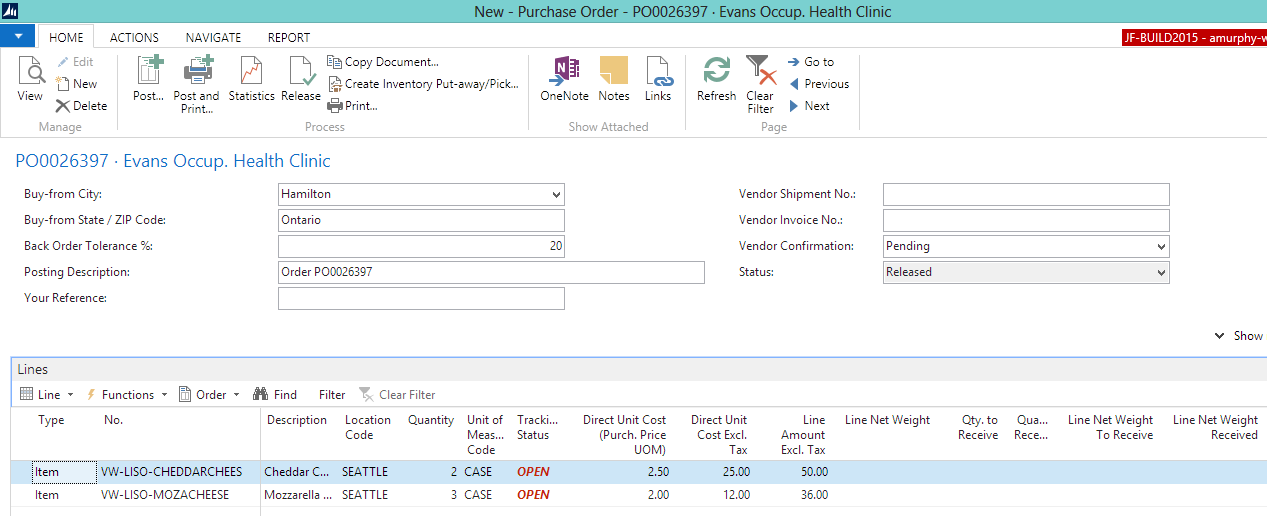
Creating a Warehouse Receipt
Prerequisites
Complete the following steps to create a warehouse receipt:
Choose the Search icon, enter purchase orders, and select Purchase Orders. The Purchase Orders window opens.
Select the released purchase order that was created for the variable weight items.
On the Home tab, choose Create Whse. Receipt.
Click OK at the message that a Warehouse Receipt Header was created. The Warehouse Receipt window opens.
Enter the tracking information for the cheddar line.
Select the VW-LISO-CHEDDARCHEESE line.
Enter 2 in the Qty. to Receive field.
On the Line tab, choose Item Tracking Lines. The Item Tracking Lines window opens.
On the Home tab, choose Assign Lot No.
In the Net Weight field, enter 21.2. The 21.2 is the total weight of the 2 cases.
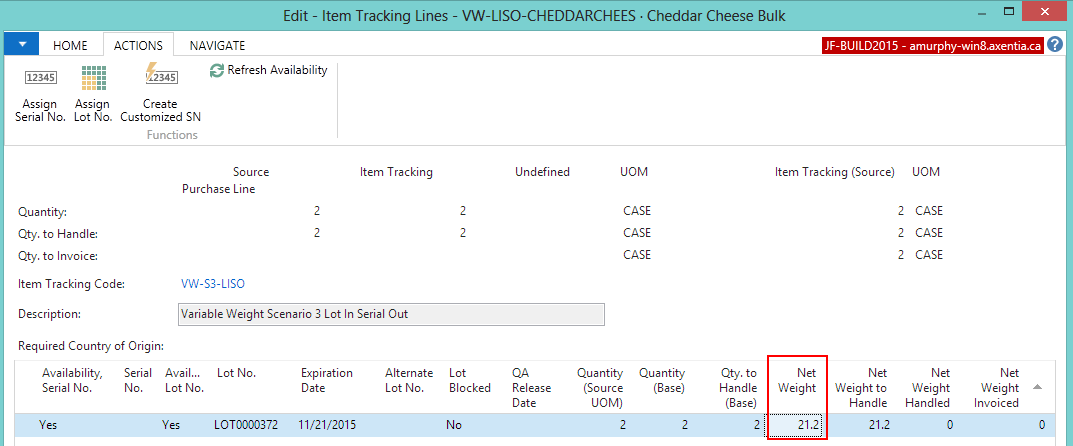
Click Close.
The Line Net Weight to Receive field is automatically populated with 21.2.
Enter the tracking information for the mozzarella line.
Select the VW-LISO-MOZACHEESE line.
Enter 3 in the Qty. to Receive field.
On the Line tab, choose Item Tracking Lines. The Item Tracking Lines window opens.
On the Home tab, choose Assign Lot No.
In the Net Weight field, enter 17.8. The 17.8 is the total weight of the 3 cases.
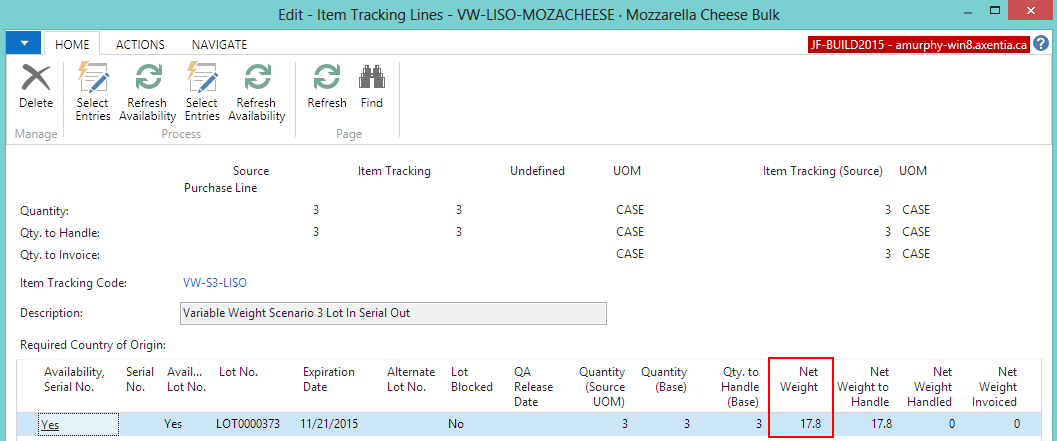
Click Close.
The Line Net Weight to Receive field is automatically populated with 17.8.
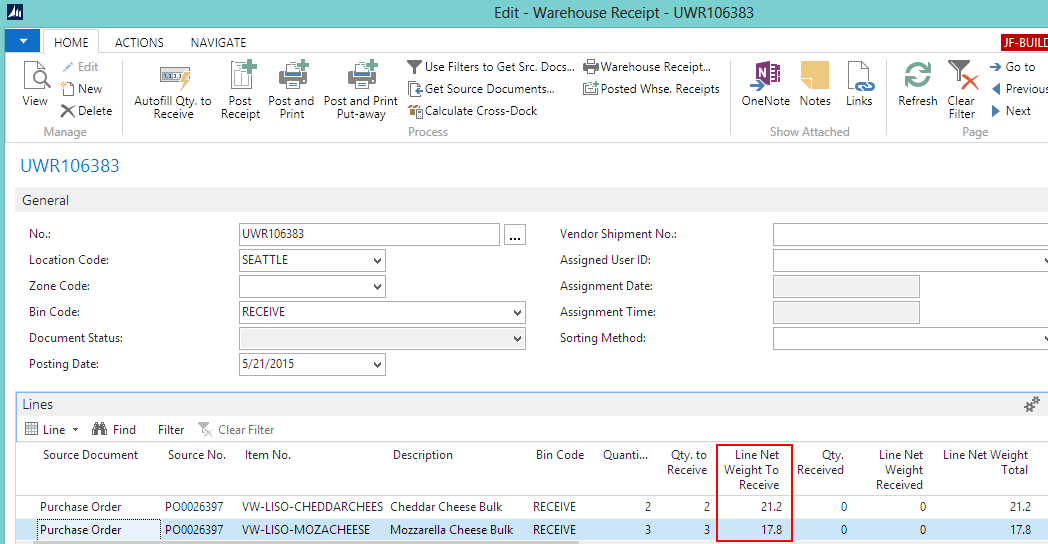
On the Home tab, in the Posting group, choose Post Receipt.
Click Yes at the question asking if you want to post the receipt.
Click OK at the message that a source document was posted, and a put-away activity was created. The Post Whse. Receipt window opens.
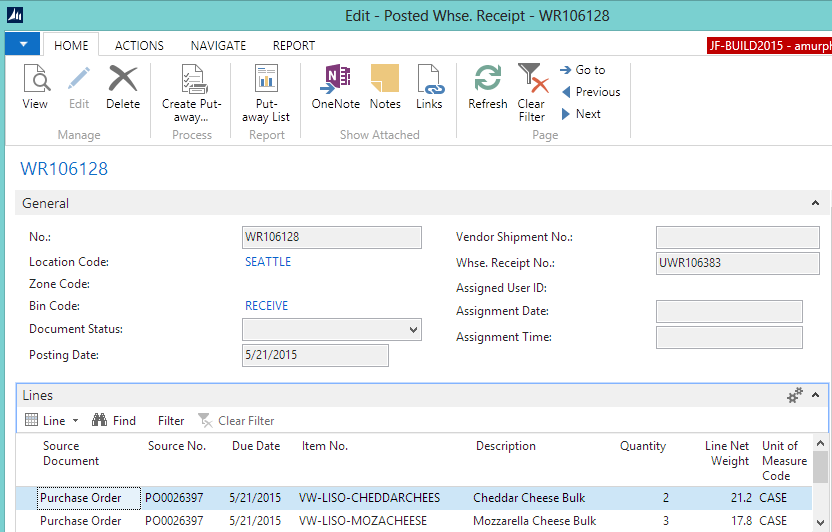
If you return to the purchase order, you can see that some of the Line Net Weight fields have been populated. The values in the Direct Unit Cost Excl. Tax fields were recalculated to reflect the weights that were received. For example, 3 cases of mozzarella weighed 17.8 pounds, and the total cost of the cases is $35.60 ($2.00 x 17.8). The cost of each case is $11.86667 ($35.60 divided by 3).
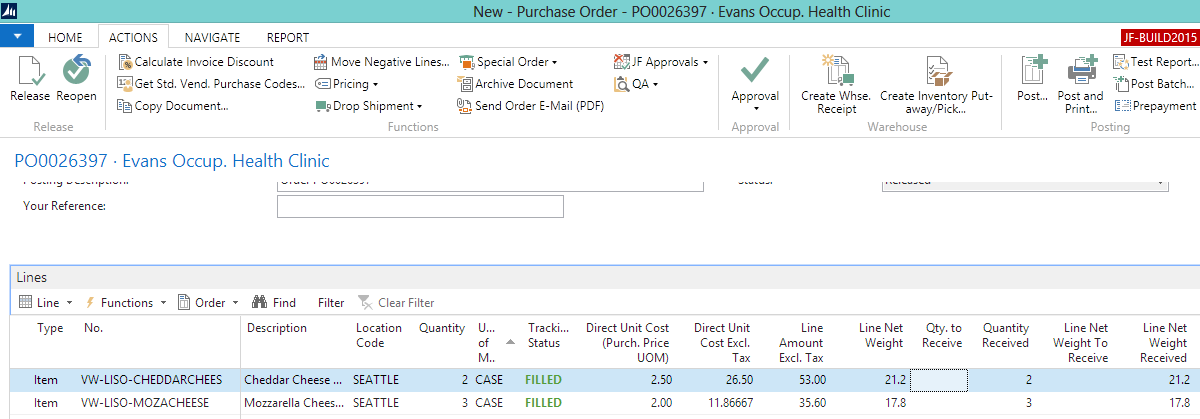
Registering the Warehouse Put-Away
Open the posted warehouse receipt if it is not already open.
On the Navigate tab, choose Put-away Lines. The Warehouse Put-away Lines window opens.
The lines show the following:
Take 2 cases of the VW-LISO-CHEDDARCHEES item (with a net weight of 21.2) from the RECEIVE bin, and place it into the A1-01-01 bin.
Take 3 cases of the VW-LISO-MOZACHEESE item (with a net weight of 17.8) from the RECEIVE bin, and place it into the A1-01-01 bin.
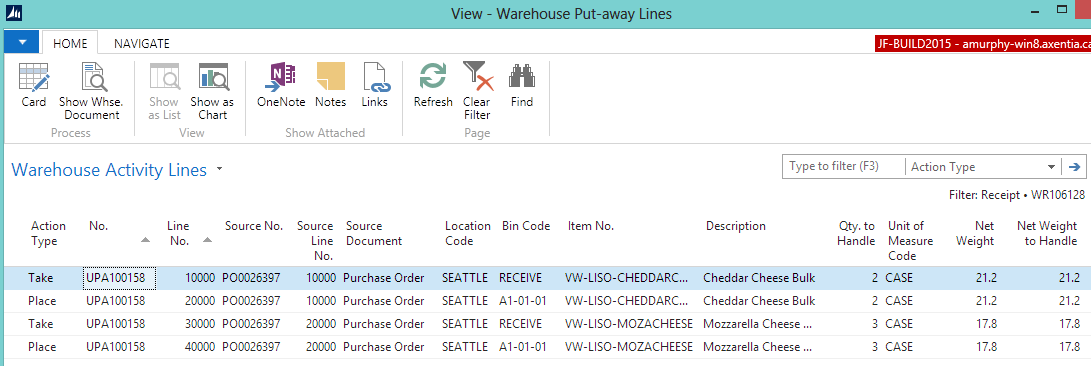
On the Home tab, in the Process group, choose Show Document. The Warehouse Put-away window opens.
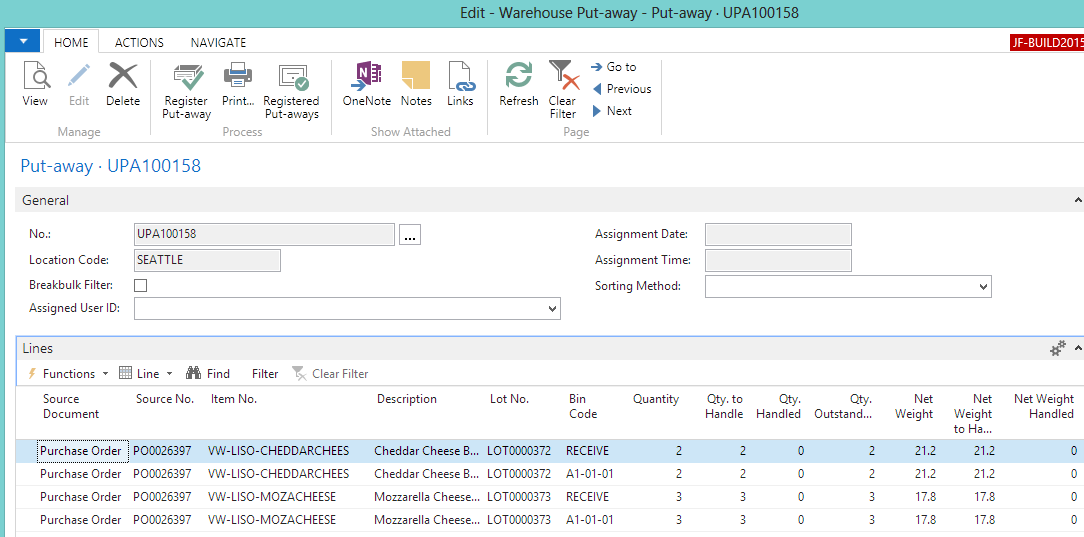
On the Home tab, in the Process group, choose Register Put-away.
Click Yes to register the Put-away document. Each lot is moved as a whole unit to the appropriate bins in JustFood.
From the Warehouse Entries window, you can see the positive adjustments, and the movement from the RECEIVE bin to the A1-01-01 bin for both of the items.
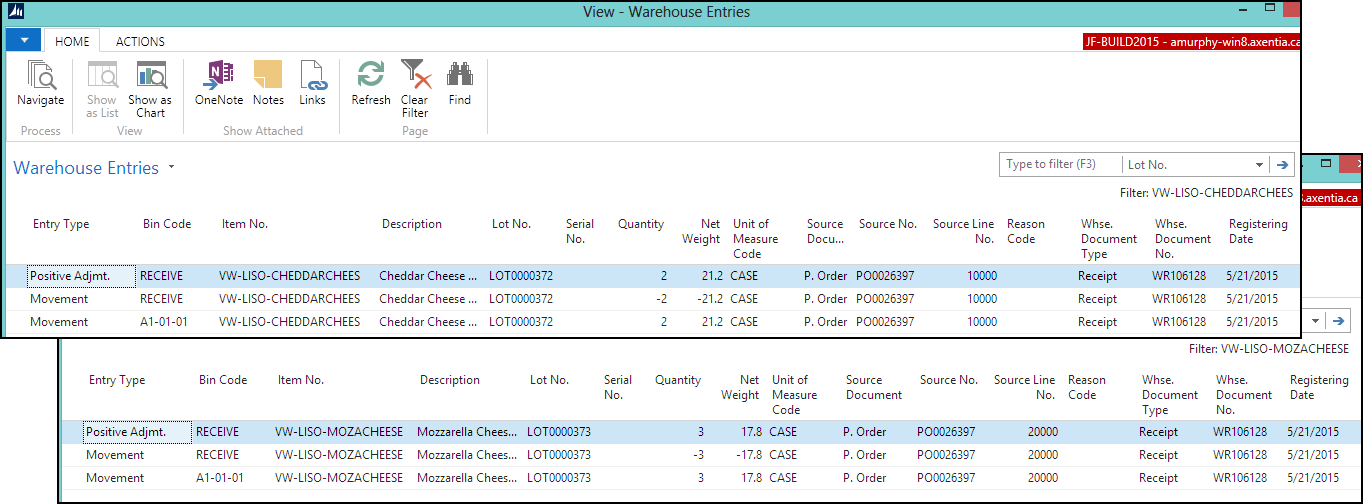
Invoicing the Variable Weight Purchase Order
When the invoice is received, the vendor has charged a $20.00 delivery surcharge. When the purchase order is invoiced, the surcharge is split between the items based on the total lot weight.
Choose the Search icon, enter purchase orders, and select Purchase Orders. The Purchase Orders window opens.
Select the released purchase order that was created for the variable weight items.
On the Home tab, choose Reopen.
On the Lines FastTab, add the following line:
| Type |
No. |
Location Code |
Quantity |
Direct Unit Cost Excl. Tax |
Qty. to Receive |
| Charge (Item) |
FREIGHT |
SEATTLE |
1 |
20.00 |
1 |

Assign the item charge.
With the item charge line selected, on the Line tab, choose Item Charge Assignment. The Item Charge Assignment window opens.
Select all of the existing lines, and choose Delete.
Click Yes to delete the selected lines.
On the Home tab, choose Get Receipt Lines. The Purch. Receipt Lines window opens.
Select the 2 lines associated with the purchase order, and click OK.

The two receipt lines are returned to the Item Charge Assignment window.
On the Home tab, choose Suggest Item Charge Assignment.
Select Weight (Gross if Not Zero Else Net).
Click OK. The Qty. to Assign field is automatically updated. The Amount to Assign is based on the weight of each lot. The total delivery charge is $20.00, and $9.13 is assigned to the 21.2 pounds of the bulk cheddar, and $10.87 is assigned to the 17.8 pounds of the bulk mozzarella.

Click Close.
On the Lines Fast Tab, in the Qty. to Invoice field, enter 2 for the bulk cheddar line, and enter 3 for the bulk mozzarella line.

On the Home tab, in the Posting group, choose Post.
Select Receive and Invoice, and click OK. The purchase order is invoiced.
The Item Ledger Entries recorded a transaction for the total lot of each item.

The Value Entries for each item show how the costs were assigned.
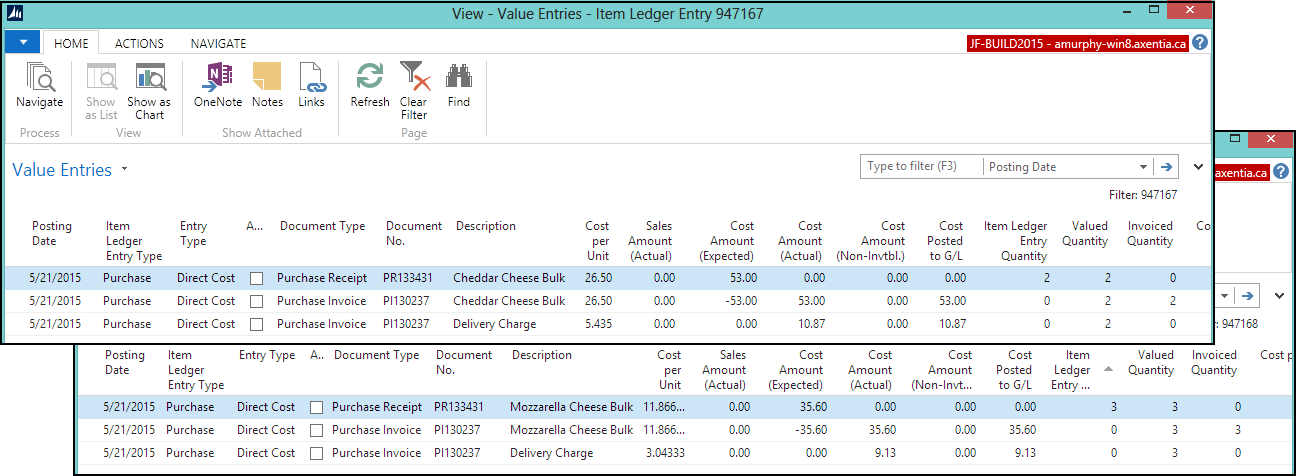
See Also
About Variable Weight
About JustFood Walkthroughs
© 2018 Microsoft and IndustryBuilt. All rights reserved.
JustFood 2018 (11.00.00.00) | February 2018
![]()
![]()
![]()
















